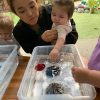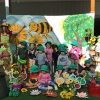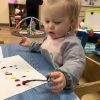![Life on Repeat Have you ever seen your child repeat an activity over and over again – tipping over the a box of toys and emptying it on the floor, rolling a car over an uneven surface over and over again? Building something only to knock it straight back over? To us adults, it can sometimes seem repetitive, […]](https://creativemindschildcare.com.au/wp-content/uploads/2019/11/0821afa7-db51-484b-9f52-7ae5ae2bb167.jpeg)
Have you ever seen your child repeat an activity over and over again – tipping over the a box of toys and emptying it on the floor, rolling a car over an uneven surface over and over again? Building something only to knock it straight back over?
To us adults, it can sometimes seem repetitive, unnecessary, and even frustrating, but to a child, this is actually a significant moment of ‘play based learning’, all part of their essential brain development and when they intentionally repeat a series of actions, it is called a ‘schema’
There are many different types of schema. Sometimes the activities children repeat over and over may seem a little strange, but to the child, it’s a necessary step in their understanding of the world and themselves, as they understand how things move, change, react and the impact that they can have on the world around them through their actions.
Each child is different, and some may investigate more than one schema while others show none at all in their learning. Schema can be observed, identified and understood by families and Educators, and with this, together we can build better awareness of each child’s current interests and ways of thinking.
By observing children in their learning and play, we begin to see these schema emerge, and to understand the questions that children are asking themselves as they play.
“What happens when I push the tower of blocks?” “How does my body move through a tunnel?” “When I throw a block, how far does it travel?”
Once we understand that the concept of ‘schema’ exists, observing our children at play takes on a whole new meaning. We are able to actively look for these cues in play, and create experiences and learning environments that extend on these ideas, allowing children to delve deeper, understand better, question further, supporting them to become confident and involved learners.
Here are some examples of schema that you might see if you begin to observe your child at play, along with ideas on :
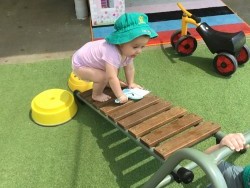 Transporting schema
Transporting schema
This is evident when children enjoy repeatedly moving resources, and themselves, from one place to another. If we observe children engaging repeatedly in the transportation schema, providing small parts such as blocks and vehicles (or anything small and mobile) will encourage them to pick up, move along and put down objects. Within outdoor learning environments, larger objects such as wheelbarrows, boxes and buckets will also support this behaviour.
 Connecting schema
Connecting schema
If you notice your child enjoys putting objects together and dragging them around, or wants to weave things, tie things, or join things together, it is likely they are exploring the connection schema. This involves investigating how materials can be linked and their relationship to one another. Providing children with an opportunity to practise connecting objects such as off cuts off pipes and guttering, magnet tiles, and puzzles allows them opportunities to explore the connection schema. Creative activities also provide endless opportunities to explore ideas of connection, as children are able to stick, staple, tie, cut and tear.
 Trajectory schema
Trajectory schema
Often children will begin to show a fascination with the movement of objects, as well as moving themselves and their bodies through space. To be able to explore this schema, children need to experience space and how movement occurs within it. Outdoors there is plenty of space for children to stack blocks on top of each other and knock them down again and again. Planks, beams and large pieces of wood are also great for making ramps and rolling objects down, exploring how they move from one location to another and what they do along the way.
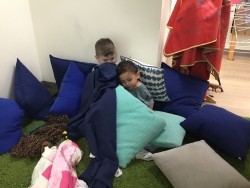 Enveloping/enclosing schema
Enveloping/enclosing schema
Children often become particularly interested in wrapping themselves up, covering and hiding items, or getting into boxes and closing the lid. Children get deeply involved in exploring how things, including themselves can fit inside other objects. If you observe your children exploring this idea, a great way to extend on this could be to provide cubby house equipment, dressing-up clothes, blankets and pieces of fabric. Barrels and tunnels are good for hiding in.
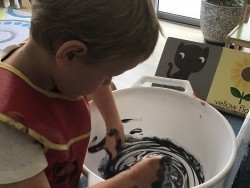 Transforming schema
Transforming schema
We often observe children becoming fascinated by how materials change their state, and there is always joy and wonder when we provide experiences that allow opportunities for mixing substances together. We love to add different elements such as water, dye and petals to the sandpit, and often observe little minds discovering how materials change consistency when wet or dry.
We hope that this information opens up a lens into the curious thought that shapes your child’s play, and that you experience the joy of understanding schema and being able to see these emerge in play, knowing that something so simple is allowing your child to explore and understand the world around them.
Thank you so much for allowing us the opportunity to support your children as curious and involved learners at Creative Minds, we would absolutely love to hear stories of schema play at home, and cannot wait to share more information about the learning and development that happens when your children come to learn alongside us here.



